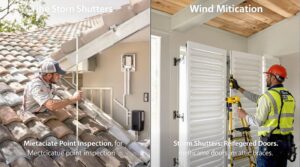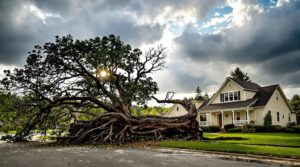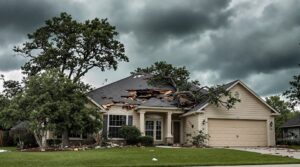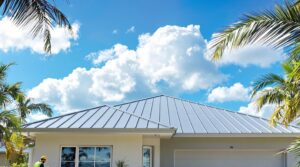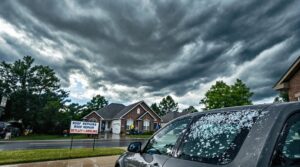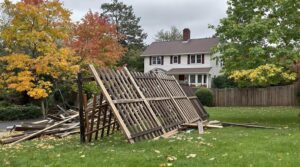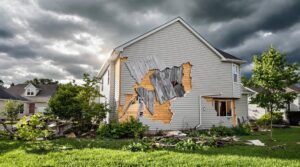Wind damage to fences is typically covered under Coverage B (other structures) of standard homeowners insurance policies, usually amounting to 10% of the dwelling coverage limit. For a $200,000 dwelling policy, this provides up to $20,000 for fence repairs. Coverage applies when damage results from severe weather events, fallen trees, or other covered perils, provided the fence was well-maintained. Several factors influence claim approval, including documentation, maintenance history, and specific policy provisions.
Key Takeaways
- Wind damage to fences is typically covered under Coverage B of homeowners insurance, usually at 10% of dwelling coverage limit.
- Coverage applies only if the fence was well-maintained and damage resulted from a covered weather event, not neglect.
- Claims require clear photographic evidence, documentation of prior maintenance, and proof that repair costs exceed the deductible.
- Most policies cover wind-related fence damage from fallen trees, but exclude normal wear and tear.
- Homeowners should consider their deductible amount before filing a claim, as repairs below deductible are better paid out-of-pocket.
Understanding Wind Damage Coverage for Fences
When homeowners face wind damage to their fences, understanding the specifics of their insurance coverage becomes essential.
Standard homeowners insurance policies typically include protection for fence damage under Coverage B, which allocates approximately 10% of the dwelling coverage limit for such structures.
The extent of coverage is directly tied to the home's primary dwelling coverage amount. For instance, a property with $200,000 in dwelling coverage would provide up to $20,000 for fence repairs resulting from wind damage.
However, certain conditions must be met for successful claims processing. Insurance providers require that fences be well-maintained and show no signs of neglect prior to the damage occurring.
To file a claim for wind damage, homeowners must demonstrate that the damage resulted from a covered peril. This process involves thorough documentation of the damage and submission of repair estimates.
Coverage limits and specific policy terms ultimately determine the compensation available for fence restoration.
Working with public insurance adjusters can help maximize settlement amounts for significant fence damage claims.
Types of Fence Damage Covered by Home Insurance
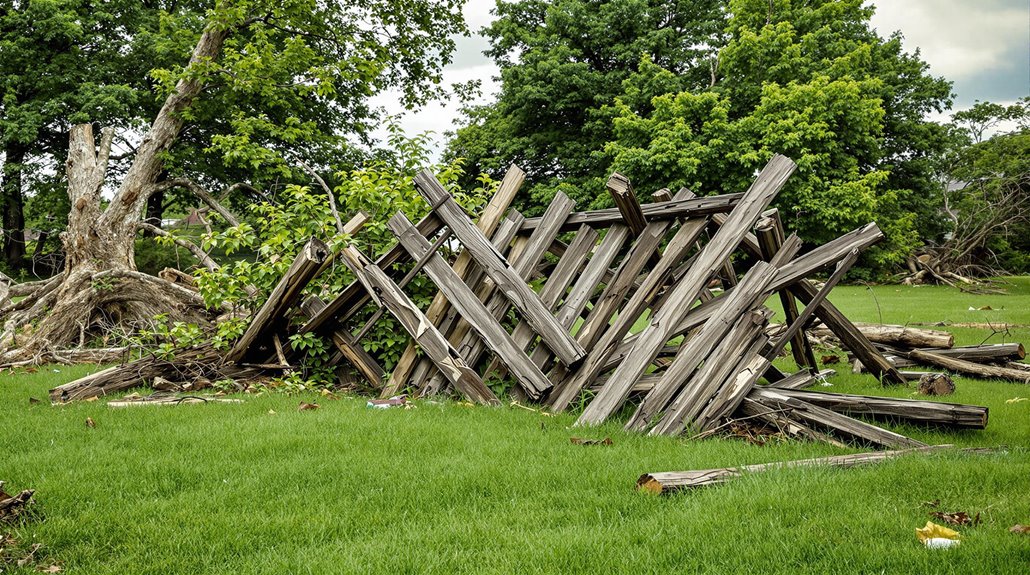
Home insurance policies typically cover five primary types of fence damage caused by natural forces and external events. Wind damage represents one of the most common claims, with coverage extending to severe weather incidents that compromise fence structural integrity.
Falling trees from neighboring properties also qualify under most homeowners policies, provided the damage results from weather-related circumstances rather than negligence.
Standard homeowners insurance additionally covers fence damage from vehicle impacts, vandalism, and certain natural disasters, subject to policy details and specific named perils or open perils coverage. The extent of coverage typically amounts to 10% of the dwelling coverage limit, establishing clear parameters for fence repairs.
However, insurers require proper fence maintenance documentation to validate claims.
For successful coverage, homeowners must review their policy details carefully, understanding the distinction between named perils versus open perils coverage, and guarantee their fence maintenance meets insurance requirements before filing claims for repairs.
Like other types of property damage claims, fence repairs require homeowners to pay their insurance deductible before receiving compensation.
Documenting and Assessing Wind-Related Fence Damage

Proper documentation of wind-related fence damage represents a critical first step in the insurance claims process. Homeowners must capture clear photographic evidence from multiple angles before initiating repairs, ensuring thorough documentation of the damage's extent and severity.
A thorough assessment involves evaluating the fence's structural integrity, identifying bent posts, displaced boards, and other compromised components. Recording specific weather conditions and timestamps of the incident strengthens the claim's validity.
Obtaining detailed repair estimates from qualified contractors helps determine if damage costs exceed insurance policy deductibles. Prior to filing an insurance claim, homeowners should review their policy's coverage specifications and potential exclusions regarding wind-related damage.
This understanding aids in accurately documenting relevant damage aspects that align with policy terms. Professional repair estimates, combined with systematic documentation of fence damage and weather data, create a substantiated claim package that facilitates efficient processing through the homeowners insurance system.
Claim filing timelines must be strictly followed to ensure proper documentation submission and avoid potential coverage denials.
Filing a Wind Damage Claim for Your Fence
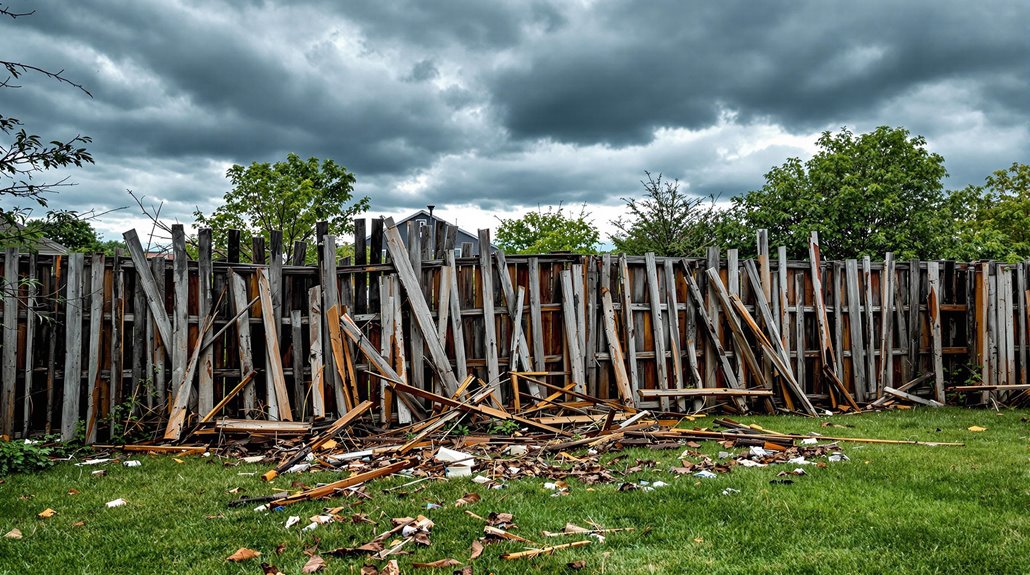
Filing an insurance claim for wind-damaged fences requires a methodical approach following detailed documentation. Homeowners must determine if repair costs exceed their deductible by obtaining estimates from contractors before initiating the claim process. Coverage for windstorm damage varies by policy, making it vital to verify specific provisions within the homeowners insurance agreement. Understanding standard policy exclusions helps prevent claim denials for fence damage that falls outside covered perils.
Key steps in the claim filing process:
- Photograph all fence sections showing visible wind damage, including close-ups of broken posts, damaged panels, and surrounding debris.
- Document the date and time of the incident, along with weather conditions and wind speeds.
- Collect written repair estimates from multiple licensed fence contractors, detailing materials and labor costs.
- Submit thorough documentation to the insurance company, including previous fence maintenance records.
The insurance adjuster will conduct an on-site assessment, making detailed documentation essential for claim approval.
Maintaining organized records throughout the process helps guarantee efficient claim resolution.
Common Exclusions and Coverage Limitations
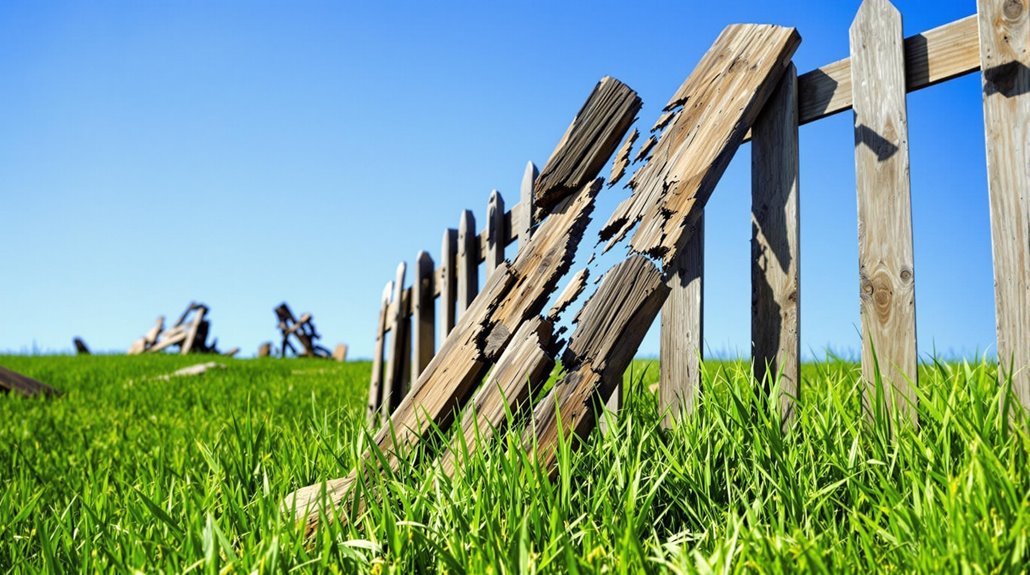
Insurance policies often contain specific wind damage restrictions that can affect fence coverage, including heightened deductibles in coastal regions and exclusions for severe weather events like hurricanes.
The standard "other structures" coverage limit of 10% of the dwelling coverage amount establishes a maximum reimbursement threshold for fence repairs.
When wind damages a fence shared between properties, insurers typically process claims based on legal ownership and may coordinate cost-sharing arrangements between neighboring property owners' respective policies.
Homeowners should note that hurricane-related losses may require additional windstorm coverage beyond a standard policy's protection.
Wind Policy Restrictions
When evaluating wind damage coverage for fences, homeowners should be aware of significant policy restrictions that can limit their ability to file successful claims. Homeowners insurance policies frequently contain specific exclusions for wind-related damage, particularly in coastal areas prone to hurricanes.
Coverage limitations typically cap fence damage reimbursement at 10% of the total dwelling coverage, while policy language may outline specific deductible amounts for storm-related incidents.
Working with independent insurance agents can help identify the best coverage options and potential restrictions for fence damage claims.
Key policy restrictions to understand:
- Wind damage exclusions in coastal zones or hurricane-prone regions
- Coverage caps limiting payouts to 10% of dwelling coverage value
- Maintenance requirements proving the fence was properly maintained pre-incident
- Specific deductible thresholds that must be met before coverage applies
Cost-Sharing Between Properties
Understanding cost-sharing responsibilities between adjacent property owners can considerably impact insurance claims for wind-damaged fences. When wind damage occurs to boundary fences, homeowners insurance cover typically falls under "other structures coverage," representing 10% of dwelling insurance. Property owners must evaluate shared responsibility and potential liability with neighboring properties.
| Aspect | Primary Coverage | Shared Considerations |
|---|---|---|
| Insurance Claims | Other structures coverage | Joint responsibility assessment |
| Damage Source | Wind damage verification | Neighbor's property contribution |
| Cost Distribution | Policy coverage limits | State-specific fence laws |
When a fence is damaged by wind, multiple factors determine cost-sharing arrangements, including state regulations, property boundaries, and contributing factors from adjacent properties. Insurance claims may involve both property owners' policies, particularly when structural support or trees from a neighbor's property contribute to the damage. Consulting a public adjuster can help maximize compensation when navigating complex shared property damage claims.
Cost Considerations and Deductibles

When evaluating whether to file an insurance claim for wind-damaged fences, homeowners must weigh repair costs against their policy deductible to determine financial viability.
Insurance coverage for fences typically extends to 10% of the total dwelling coverage, establishing a clear ceiling for potential claims and reimbursement amounts.
Homeowners facing repair costs below their deductible should consider direct out-of-pocket payment, as this approach prevents potential premium increases while preserving their claims history for more substantial damages.
Understanding your coverage customization options can help ensure your fence is adequately protected while maintaining cost-effective premiums.
Deductible Vs Repair Costs
Before filing an insurance claim for wind-damaged fences, homeowners must carefully weigh their policy deductible against the estimated repair costs. The financial benefit of filing a claim depends on whether repair expenses exceed the deductible amount, considering that coverage for other structures typically represents 10% of the dwelling coverage limit.
Key factors to evaluate include:
- Actual repair cost estimates from qualified contractors
- Policy deductible amount that must be paid out-of-pocket
- Available coverage limit under the other structures provision
- Long-term impact on insurance premiums after filing a claim
When repair costs fall below the deductible threshold, proceeding with an insurance claim may not be financially beneficial.
Understanding these elements enables homeowners to make informed decisions about utilizing their wind damage coverage for fence repairs.
Working with public adjusters can help ensure fair settlements and maximize claim payouts for wind-damaged fences.
Insurance Policy Limit Impact
Insurance policy limits play an important role in determining the financial coverage available for wind-damaged fences, with most standard homeowners policies allocating approximately 10% of the dwelling coverage amount toward other structures.
| Coverage Component | Impact Factor | Financial Consideration |
|---|---|---|
| Dwelling Coverage | 10% Rule | Maximum Fence Coverage |
| Claim Deductible | Direct Impact | Repair Cost Threshold |
| Wind Damage | Covered Peril | Insurance Recovery |
Understanding these coverage limits is vital for effective financial recovery when fence damage occurs. Property owners must evaluate their home insurance policy to guarantee adequate protection, particularly in wind-prone areas. When reviewing potential claims, homeowners should consider both the fence damage repair costs and their claim deductible to determine if filing a claim is financially beneficial. Regular policy reviews help maintain appropriate coverage levels for the best insurance coverage against wind-related property damage liability. Reviewing your policy's liability coverage exclusions can prevent unexpected gaps in protection for fence-related incidents.
Out-of-Pocket Payment Options
Financial considerations surrounding wind damage to fences extend beyond insurance policy limits to the specific out-of-pocket expenses homeowners must evaluate.
When determining payment options for fence repairs, homeowners need to assess repair costs against their deductible, as claims below the deductible amount require full out-of-pocket payment.
Key payment considerations include:
- Standard deductible amounts that must be met before homeowners insurance coverage begins
- The 10% limit of dwelling coverage typically allocated for other structures coverage
- Percentage-based deductibles that may increase out-of-pocket expenses in high-value areas
- Total repair costs that determine whether filing a claim is financially advantageous
Understanding these factors helps homeowners make informed decisions about whether to file a claim for wind damage or handle repairs independently through personal financing.
Steps to Protect Your Fence From Wind Damage
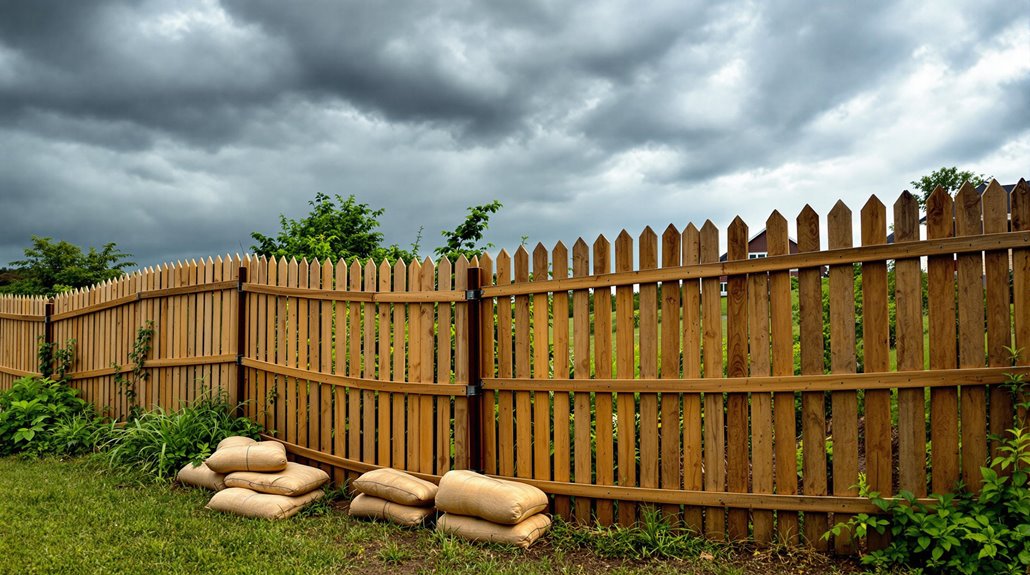
Taking proactive measures to protect fences from wind damage can considerably extend their lifespan and prevent costly repairs. Regular fence maintenance involves thorough inspections to identify potential vulnerabilities and address them before windstorms occur.
To enhance structural integrity, property owners should focus on proper installation techniques, ensuring fence posts are buried at least one-third of their height and secured with concrete.
Reinforcement strategies include adding horizontal supports and selecting materials specifically designed for high winds. Wind resistance can be improved through aerodynamic design modifications, particularly in areas frequently experiencing severe weather conditions.
Protecting fence structures also requires managing surrounding hazards. Regular trimming of nearby tree branches eliminates the risk of falling limbs during storms.
For ideal results, consulting professionals who specialize in wind-resistant fencing can provide tailored solutions based on local weather patterns and specific property requirements. These preventive measures appreciably reduce the likelihood of wind-related fence damage.
Working With Insurance Adjusters on Fence Claims

When wind damages a fence, property owners must navigate the claims process by working effectively with insurance adjusters. The insurance adjuster evaluates whether the damage falls under the windstorm peril coverage in the homeowners insurance policy, considering factors such as maintenance history and coverage eligibility.
Key steps when working with an adjuster on a fence damage claim include:
- Gathering extensive photographic evidence of the wind damage from multiple angles
- Obtaining detailed repair estimates from qualified contractors
- Compiling maintenance records to demonstrate proper fence upkeep
- Documenting the date and circumstances of the damage event
Maintaining clear communication with the adjuster throughout the process is essential, as they may request additional documentation to support the claim.
Property owners should also understand their deductible amount, as this determines whether filing a claim is financially beneficial, considering the assessed repair costs.
Frequently Asked Questions
Will Insurance Cover Wind Damage to a Fence?
Insurance policies typically cover fence repair from wind damage, subject to coverage limits and deductible amounts. Homeowner responsibilities include proper fence maintenance and following the claim process for storm-related damages.
How Much Will Insurance Pay for a Damaged Fence?
Insurance coverage for damaged fences typically ranges up to 10% of dwelling coverage, minus deductibles. Actual payout depends on policy limits, damage assessment, maintenance history, and repair versus replacement costs.
Does a Home Warranty Cover Fence Damage From Wind?
Like a breeze through empty branches, home warranties offer no shelter for wind-damaged fences. Standard warranty exclusions specifically omit exterior structures, leaving fence maintenance and repair costs to homeowners insurance coverage.
What Is Considered Wind Damage for Insurance?
Insurance-recognized wind damage encompasses structural failures from high wind velocity effects on fence materials, including breaking, bending, or uprooting, subject to policy exclusions and proper maintenance documentation requirements.
Final Thoughts
While standard homeowners insurance typically covers wind damage to fences, policyholders must carefully evaluate their coverage limits and deductibles before filing claims. Although some may argue that maintaining fences against wind damage is solely the homeowner's responsibility, documented severe weather events constitute legitimate claims under most policies. Regular documentation, proper maintenance, and understanding specific policy provisions remain essential for successful fence-related insurance claims and long-term property protection.
For homeowners dealing with fence damage or any other property damage covered by their homeowners insurance policy, insurance industry professionals and legal experts strongly advise consulting a qualified state-licensed public adjuster. Public adjusters work exclusively for policyholders, not insurance companies, serving as dedicated advocates throughout the claims process. These state-licensed professionals help navigate complex insurance policies, identify hidden damages often unknown to policyholders, thoroughly document losses, and negotiate with insurance companies to ensure fair settlements while protecting policyholder rights.
Working with a public adjuster can significantly increase claim payouts, expedite the claims process, and reduce the stress of dealing with insurance companies, allowing homeowners to focus on recovery. Policyholders interested in discussing their property damage claims can request a no-obligation free consultation with a Public Claims Adjusters Network (PCAN) member public adjuster through our contact page.
